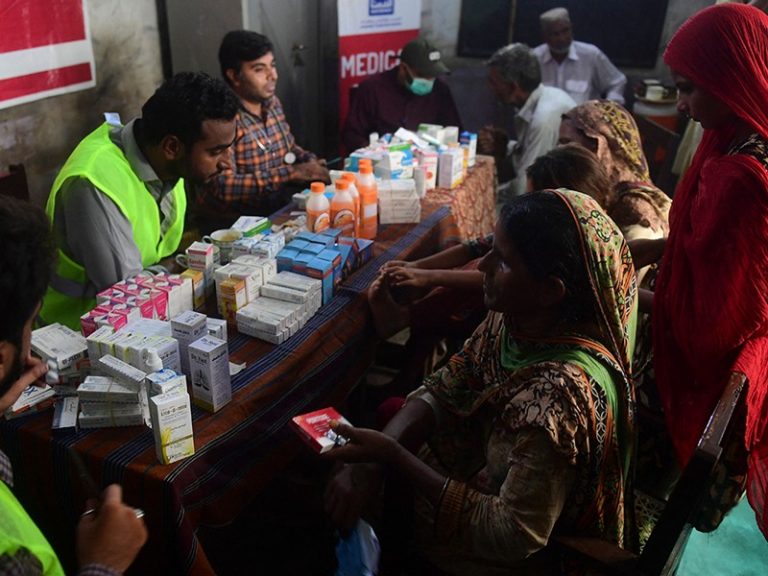
“We plan to prepare maternal and newborn kits that include clean delivery sheets, blankets, disinfectants and sunflower massage oil,” Aga Khan University Karachi’s researchers say.
Smriti Mallapaty
With more than a one-third of Pakistan affected by flooding, millions of people are in need of food, shelter and medical care. Researchers, along with the government, international aid agencies and local organizations are racing to provide assistance ahead of more rain predicted this month.
Nature spoke with Sajid Soofi and Zahid Memon, who study women’s and children’s health at Aga Khan University, in Karachi, about how university employees have pivoted to provide much-needed medical aid, and the challenges they face with more than 30 million people displaced across the country.
What kind of relief work is your university doing?
SS: Because we are an academic institution with one of the leading hospitals in Pakistan, the Aga Khan University Hospital, our primary response to the floods has been to provide medical care, with a particular focus on pregnant women and children. The university has mobilized a few thousand staff members, students and volunteers in the relief effort.
ZM: We are coordinating with the government to provide medical care to more than 24,000 people in more than 80 health-care camps and mobile units across several districts in the southern coastal provinces of Sindh and Balochistan, which have been affected by the floods and where there are displaced populations. Before the flooding, our medical workers would visit health facilities and collect information about supplies — but they are now consulting with patients and prescribing medicines. And staff members who were previously involved in community mobilization are now supporting medical personnel by establishing camps, dispensing medication and counselling people.
The work is not unfamiliar to us. We deployed teams to respond to the major flooding in 2010 and the 7.6-magnitude earthquake that hit Pakistan in 2005. But the scale and severity of the disaster this time are much larger than we have seen before. The extensive flooding has already created huge problems in accessing flood-affected regions, especially because many highways are underwater.
What are the main challenges?
SS: One major issue is caring for pregnant women and newborns. Of the 32 million people displaced by the floods, it is estimated that some 650,000 are pregnant, and more than 70,000 are expected to deliver their babies this month. This is a huge number, but the health facilities in flood-affected districts cannot function as they should. We plan to prepare maternal and newborn kits that include clean delivery sheets, blankets, disinfectants and sunflower massage oil.
Because access to clean water is limited, we are trying to provide chlorine tablets for purifying water and oral rehydration salts for treating diarrhea, especially in children. Such heavy rains will also stimulate mosquito reproduction, which will fuel outbreaks of malaria and dengue.
Another problem is malnutrition. We already have a very high prevalence of malnutrition in women, especially during pregnancy, and some 40% of children in the province of Sindh — a heavily affected region — are stunted, which means they are not as tall as they should be for their age. The food insecurity caused by these floods will further exacerbate malnutrition. We are trying to provide semi-solid food supplements for extra calories, especially for pregnant women and children.
We hope to continue running extensive health camps for about one month, and then will focus on a smaller number of districts for another two months. We are hiring staff to work on the relief efforts, and hope to return to our normal research activities within a couple of weeks.
How have the floods affected your research?
SS: Our research primarily focuses on maternal, newborn and children’s health. We also study vaccine-preventable diseases, polio and reproductive health, including family planning.
ZM: Some of our research has continued despite the flooding. For example, we are still collecting data on health systems to look for patterns in the use of existing facilities and their capacity. Going forward, we hope to use this data to assess the impact of the floods on those services, and what was neglected. Reproductive-health and family-planning interventions are recommended during flood disasters, so we are prioritizing those activities wherever possible.
But much of our work is conducted in rural and remote districts that are among the worst hit by the floods. Almost all of the districts we work in have been affected. We can’t visit villages that are now underwater to conduct surveys, and we can’t ask participants about our interventions at a time when they are under distress. However, because our staff members are already in these hard-to-reach districts, we have enlisted them in the relief effort, and our offices are being used as warehouses for storing medicines and supplies.
____________________
Courtesy: Nature